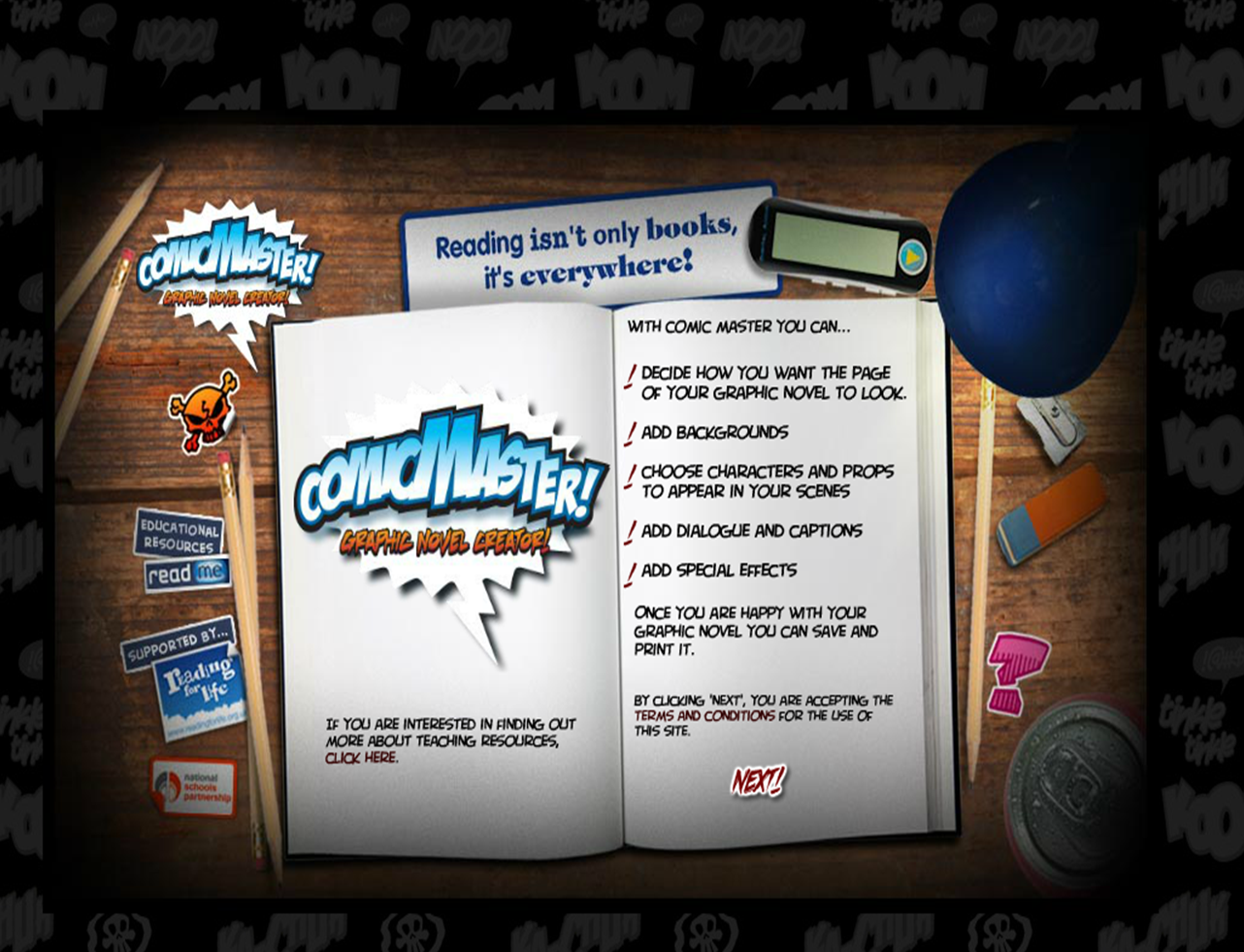Comics have been used extensively in the educational field to engage learners either as “consumers” of narratives created by others, or as “creators” of their own stories. Reading and creating comics, as any other storytelling activity, helps the development of cognitive and communicative skills, facilitates meaning making, enhances writing and reading skills while fostering creativity (Chun 2009; Derrick 2008). Comics are a very popular medium defined by McCloud as: “juxtaposed pictorial and other images in deliberate sequence, intended to convey information and/or produce an aesthetic response in the viewer” (1993:9).
There are several, freely available, online resources where students can create personalised, interactive, web based comics or webcomics. Comic Master (fig. 1) is one such tool; students can engage in a compelling digital storytelling activity in their target language. Webcomics activities can be easily conducted both inside and outside the classroom.
Some of the benefits of using web comics in the language acquisition process include an increase in student engagement and creativity and fun, the promotion of goal orientated attitudes, the enhancement and support of collaborative work as well as fostering self-reflection and critical thinking (Di Blas, Paolini, & Sabiescu, 2010).

Upon completion of this task students will be able to:
- produce written texts appropriate to their CEFR level.
- organise, analyse, and reflecting on their selected material
- collaborate on multi-literacy, with a focus on graphics and texts to tell a story
Procedure
Comic Master is a free web application that allows your students to easily create comics online.
- Open http://www.comicmaster.org.uk/
- Students must register so that they can save their work.
- Follow the online instructions to guide you through the process of creating a comic or watch the tutorial below.
- Save often (disk icon).
- Print to Adobe PDF to create a PDF file.
- Note: this application can also be used without registration.
- Tutorial: https://www.youtube.com/watch?v=SjCIF5kHmlc
Suggested activities
There are many types of activities that can be developed for use in the language classroom, teachers could focus, for example, on grammar points or literacy, discussing how to develop a good plot in the target language, introducing characters and different situations. Once students have come up with their own ideas and written text, teachers could allow them to work on their comics outside classroom.
Features
- Design your page layout by selecting from different size panels
- There are 6 different themed backgrounds
- Different Characters (each in a variety of poses)
- A variety of speech bubbles
- A variety of props to help customize your story
- Drag and drop function
- Easy save, load and print features
- Inbuilt music player
Suggestions for assessment
Project-work, Comics Presentation: students can work in small groups – 2/3 people- or by themselves presenting comics they have created. These comics may be based on specific topics introduced and discussed during the language class.
Bibliography
Cary, S. (2004). Going graphic: Comics at work in the multilingual classroom. Portsmouth, NH: Heinemann.
Chun, C. W. (2009). Critical Literacies and Graphic Novels for English‐Language Learners: Teaching Maus. Journal of Adolescent & Adult Literacy, 53(2), 144-153.
Derrick, J. (2008). Using comics with ESL/EFL students. The Internet TESL Journal, 14(7).
Di Blas, N., Paolini, P., & Sabiescu, A. G. (2012). Collective digital storytelling at school: a whole-class interaction. International Journal of Arts and Technology, 5(2-4), 271-292.
Jacobs, D. (2007). More than words: Comics as a means of teaching multiple literacies. English Journal, 19-25.
McCloud, S. (1993). Understanding comics: The invisible art. Northampton, Mass.
Mirabile, V., Morato, A., Sanna, T. & Di Paolo, F. (2015). L’ITALIANO TRA LE NUVOLE GLI STRUMENTI DEL WEB 2.0 PER CORSI IN CONTESTO LS. Bollettino Itals, 13(59).
Thorne, S. L., Black, R. W., & Sykes, J. M. (2009). Second language use, socialization, and learning in Internet interest communities and online gaming. The Modern Language Journal, 93(s1), 802-821.
Williams, R. M. C. (2008). Image, text, and story: Comics and graphic novels in the classroom. Art Education, 61(6), 13-19.
Source/attribution: DigiLanguages Author: Silvia Benini
11 sites pour créer des bds en ligne
Pixton a même une version française.
Ici vous allez trouver un clip video pour vous expliquer comment créer une bd avec ToonDoo
Creare fumetti in italiano è un’attività estremamente stimolante non solo per gli studenti ma anche per gli insegnanti.
Nella pagina almaedizioni italiano con i fumetti troverete bellissimi esempi di storie a fumetti da leggere ed ascoltare. Per ognuna delle storie presentate, è disponibile una versione animata on-line arricchita da musiche, effetti sonori e voci di attori professionisti. Perdetevi in questi fumetti, saranno un’ottima fonte d’ispirazione per la creazione dei vostri con comicmaster.
Author: Silvia Benini

